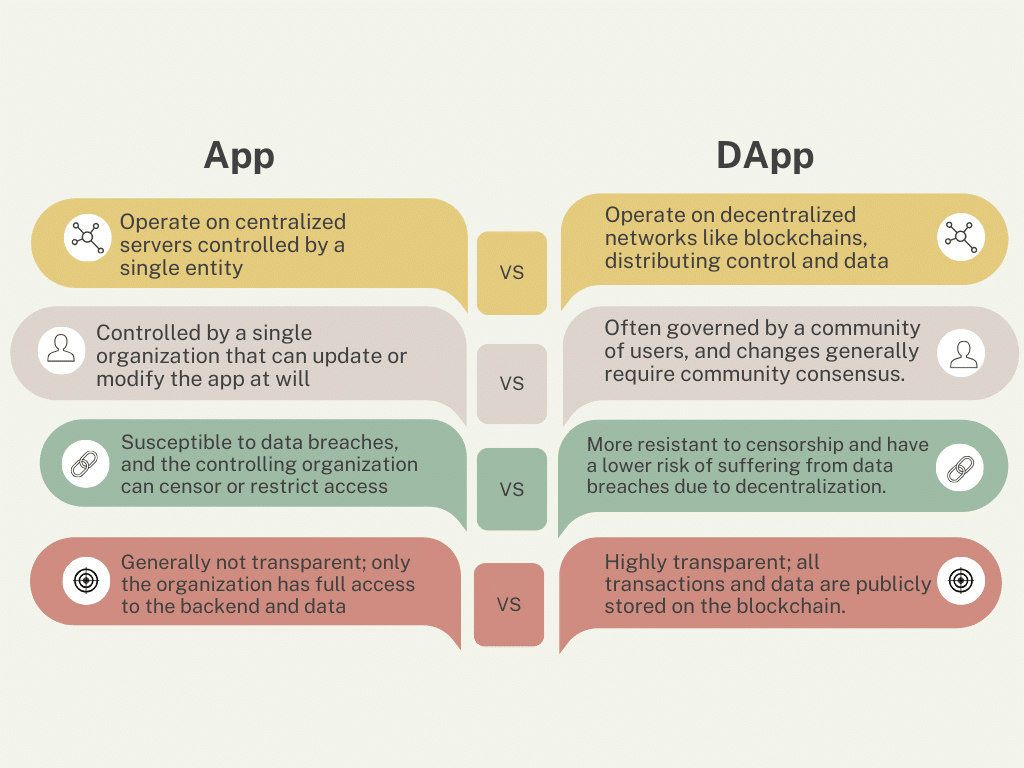In the world of digital technology, the term “app” has become ubiquitous. From the apps on our smartphones to the software we use on our computers, they make our lives easier, more productive, and often more entertaining. However, a new term has started gaining traction in recent years: “DApp,” or decentralized application. While both apps and DApps serve similar functionalities, the fundamental technology behind them is different.
What is an App?
What is an app, or application, is a type of software that allows users to perform specific tasks. This could range from something as simple as a calculator to as complex as a full-featured video editing suite. Apps typically run on a centralized server, meaning all the data and control lie with a single entity or organization.
Example: Facebook
Take Facebook, for example. This social media platform is an app in the sense that users can install it on their mobile devices or access it via web browsers. All the data—your posts, likes, friend lists—are stored on Facebook’s centralized servers. This centralization allows for quick updates and changes, but it also means that Facebook has complete control over the app and its data.
What is a DApp?
A decentralized application (DApp) serves a similar purpose to a traditional app but operates on a decentralized network, like a blockchain. Unlike centralized apps, DApps distribute the data across multiple points rather than storing it on a central server. This makes them transparent, resistant to censorship, and less likely to suffer from single points of failure.
Example: Uniswap
One popular example of a DApp is Uniswap, a decentralized exchange that allows users to swap different types of cryptocurrency without the need for a middleman. Uniswap operates on the Ethereum blockchain, and because it’s decentralized, it’s resistant to censorship and does not require users to trust a central authority. Anyone can audit the smart contracts that power Uniswap, and the data is transparently stored on the blockchain.
Key Differences
- Centralization vs Decentralization
Apps: Operate on centralized servers controlled by a single entity.
DApps: Operate on decentralized networks like blockchains, distributing control and data. - Governance
Apps: Controlled by a single organization that can update or modify the app at will.
DApps: Often governed by a community of users, and changes generally require community consensus. - Security and Censorship
Apps: Susceptible to data breaches, and the controlling organization can censor or restrict access.
DApps: More resistant to censorship and have a lower risk of suffering from data breaches due to decentralization. - Transparency
Apps: Generally not transparent; only the organization has full access to the backend and data.
DApps: Highly transparent; all transactions and data are publicly stored on the blockchain.
App-vs-DApp-the-future-of-software-application-
The Future of Apps and DApps
Traditional apps are unlikely to go away anytime soon. Their centralized structure allows for rapid development, efficient troubleshooting, and seamless user experiences. However, DApps offer compelling advantages in terms of security, transparency, and decentralization that make them increasingly appealing for various use-cases.
The likelihood is that the future will see a coexistence of both apps and DApps, each serving different needs and markets. As blockchain technology matures, we can expect DApps to become more user-friendly, potentially closing the ease-of-use gap that currently exists between them and traditional apps.
In conclusion, while apps and DApps may offer similar functionalities, understanding the fundamental differences between them is crucial for grasping the future landscape of digital technology. Whether centralized or decentralized, both have unique features that make them suitable for different kinds of tasks and audiences.

